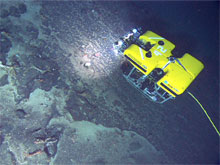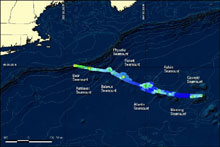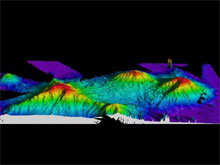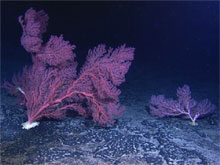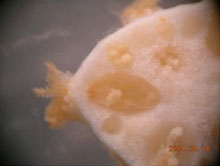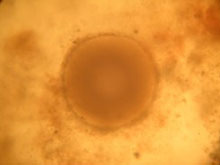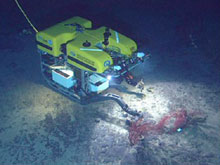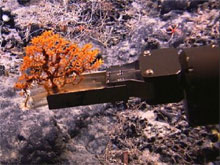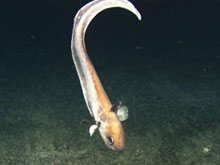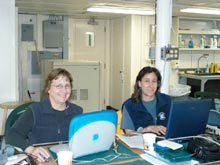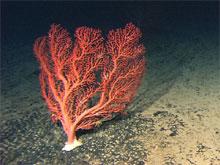The ROV Hercules, as seen from the ROV Argus. This photo illustrates the illuminative capacity of the combined systems' HMI lights. Click image for larger view.
Mountains in the Sea 2004: Exploring the New England Seamount Chain
Mission Summary
July 30 - August 23, 2004
We completed another very successful expedition to the New England Seamount Chain, meeting or exceeding all of our objectives.
A snapshot of the expedition accomplishments includes:
• diving on five seamounts;
• collecting extensive multibeam data of much of the northern New England Seamount Chain;
• conducting a deep-dive test of the remotely operated vehicle (ROV) Hercules;
• collecting over 100 coral samples;
• identifying dozens of fish species;
• collecting thousands of digital still images and frame captures; and
• conducting five, live, interactive, 45-min Web casts during the final week.
The success of this cruise was the result of hard work by the multidisciplinary research and education team, the skill of the crew of the NOAA research vessel Ronald H. Brown, the exemplary performance of the ROV team (assembled by the Institute for Exploration to support our mission), and the significant contributions made by the Ocean Exploration support staff. Good weather and mostly calm seas also contributed greatly to our success. This combination of talent and good weather resulted in our Mountains in the Sea research team spending 157 hours -- or the equivalent of six days -- underwater during the expedition.
As a result of this work, combined with last year's successful Mountains in the Sea expedition, we have an outstanding data set that includes the identification of new species; the acquisition of enough multibeam data to develop a reasonably comprehensive atlas of the northern New England Seamount Chain; the collection of adequate deep-sea coral samples to begin to understand the relationships between the various taxa from various seamounts; and the accumulation of significant data on coral growth and mapped intra- and inter-seamount coral distributions.
This map shows 2004 multibeam mapping efforts from the Ronald H. Brown. Click image for larger view.
Multibeam Mapping
Ivar G. Babb
Principal Investigator -- Mountains in the Sea
Kevin Joy
National Undersea Research Center University of Connecticut
Allen Gontz
Graduate Student
University of Maine
The New England seamounts form a southeast-trending chain of underwater peaks, running from Bear Seamount (located 200 mi from Woods Hole, MA) to Nashville Seamount -- a distance of about 700 mi. The first objective of this expedition was to produce maps of the seamounts targeted for exploratory dives.
During the Mountains in the Sea 2003 expedition, we focused on three seamounts: Manning, Kelvin, and Bear, mapping them with the R/V Atlantis' Seabeam 2112 12KHz swath bathymetric sonar system. As its name implies, a multibeam sonar emits sound pulses from an array of hull-mounted transducers and records the time it takes for the signal to return from the sea floor to calculate depth.
A multibeam map processed into three-dimensional image of the Manning Seamount complex. Click image for larger view.
The NOAA ship Ronald H. Brown has the same multibeam system, which can map and produce sea-floor acoustic backscatter imaging in water depths ranging from 10-11,000 m. This translates into a map swath under the ship that varies as a function of depth, becoming narrower in deeper water (e.g. the sonar beams spread to 150º at 1,000 m, 120º at 5,000 m, and 90º at 11,000 m).
Our 2004 mapping efforts were aimed at filling in as many data “holes” from 2003 as possible, as well as mapping new seamounts. The overall mapping track began at the edge of the continental shelf south of Georges Bank, as we entered deep water. The map highlighted more rugged topography than we anticipated (based on existing bathymetry) as we proceeded to Bear Seamount.
After diving on Bear, we transited to Manning Seamount, attempting to map Physalia, Retriever, Balanus, and some of Gosnold and Sheldrake seamounts en route. We dove on one of Manning's five peaks, then filled in a data gap between other peaks on Manning.
The mapping transect then ran from Manning back to Kelvin. We were able to map additional areas south of Kelvin to Atlantis Seamount, while repairs were being made to the ROV. (After making its first dive to 3,900 m, in preparation for diving on the Titanic on the next Ocean Explorer mission, the ROV needed some work.) From Kelvin, we mapped north to Balanus, Pickett, and Retriever seamounts.
We plan on combining the data sets from 2003 and 2004 into an atlas of maps, three-dimensional images, and flythrough movies of the New England Seamount Chain.
Mapping the Distribution of Octocorals and Assessing the Overall Biodiversity of Seamounts
Les Watling
University of Maine
Chief Scientist -- Mountains in the Sea
Jon Moore
Assistant Professor
Wilkes Honors College
Florida Atlantic University
Peter Auster
Fish Biologist
National Undersea Research Center
University of Connecticut
The ROVs Hercules and Argus proved to be excellent platforms for recording the distribution and abundance of deep-sea corals, as well as the other organisms inhabiting the seamounts. The two-vehicle configuration, with the Argus hovering 20-30 m over the Hercules, was perfect for mapping small-scale coral distribution.
The 2400 watts of HMI lighting and the high-definition TV camera on Argus provided an outstanding perspective of the small-scale topography. The larger Hercules vehicle used this perspective to maneuver and to investigate and collect samples. The high-definition video and digital still cameras provided massive data sets; these are currently being analyzed and reviewed to add to the species lists from each of the seamounts.
Based on preliminary photographic surveying and the selective sampling completed during this expedition, we know we have once again expanded our knowledge of the animals living on these seamounts. Most of the over 470 specimens collected from the seamounts will be deposited in the Smithsonian's National Museum of Natural History and the Peabody Museum of Natural History at Yale University. Our preliminary collections indicate at least 27 octocoral species, 8 black coral species, 2 stony coral species, 7 species of sponges, 15 species of polychaete worms, 16 crustaceans, 5 molluscs, 4 species of brittle stars, 1 sea star, 4 anemones, and several other invertebrates. Analysis of these voucher specimens and photographic evidence will take some time, but the efforts will expand this list of species even further.
In addition, our team custom built two insulated “bioboxes” for the ROV Hercules. The bioboxes enabled us to store specimens at ambient water temperature throughout the dives, especially as the vehicle was recovered from the warmer Gulf Stream waters.
We also examined all the collected octocorals for associated invertebrates, which (if present) were removed and preserved separately. One associate, the polynoid polychaete Gorgoniapolynoe caeciliae was reproductive. (The polychaete lives in tunnels made by the modified sclerites of the primnoid, Candidella imbricata.) We preserved the specimen so its gonadal structures could be examined upon return to the laboratory. In another case, we found pregnant females of a deep-sea version of a snapping shrimp, living among the branches of the various chrysogorgiid species that occur on these seamounts.
In addition to adding to the species list, the corals we collected also served to help us reach other mission objectives. We kept live corals at ambient temperatures and examined them for preliminary classification, polyp morphology and behavior, and reproductive state. A video-microscope enabled us to make close-up records of the coral colonies; and we preserved skeletal and tissue samples for morphological analyses.
Taxonomic and Reproductive Studies of Octocorals
Kevin Eckelbarger
Anne Simpson
Graduate Student
University of Maine
The dominant hard-bottom fauna of seamounts are deep-sea corals, primarily gorgonian octocorals. The goal of our study was to document the corals present on these seamounts and to compare species composition, abundance, and diversity between seamounts. We were also interested in how these factors change with depth on the seamounts.
To address these questions, we conducted both vertical and horizontal transects on each seamount. Horizontal transects were conducted at each of three depths: 700 m, 1700 m, and 2700 m. We collected voucher specimens of as many coral species as possible on each seamount. We also collected other dominant invertebrates, including sponges and echinoderms, to aid in the identifications of corals and other invertebrates observed on the transects. We collected conductivity-temperature-density (CTD) data on CTD casts and on the submersible; we will compare this to coral distribution data. Finally, we collected tissue samples from 59 octocoral specimens in 8 different families. This material is being used to: (1) describe the reproductive morphology of octocorals from the New England seamounts; and (2) examine classical morphological characters (such as sclerite type) in combination with reproductive characters (including cell ultrastructure) to identify deep-dwelling octocorals species.
Prior to the Mountains in the Sea expedition, we knew little about the timing of gametogenesis in deep-water octocorals. We were pleased to discover that nearly half of the colonies we examined contained eggs in various stages of development. We also observed live sperm and developing embryos in several colonies. The presence of embryos in coral tissues suggests that brooding may be one reproductive strategy employed by some deep-dwelling octocorals.
There will likely be at least a few coral species that are new to science among our collections. We collected one specimen of Chrysogorgid that may be new; it is the only collection from this family from either the 2003 or 2004 cruise. We also collected several species of Paragorgiids, at least one to two of which may be new species. Finally, we extended the northern edge of the range for the family Coralliidae from Patton Seamount (collected on the 2003 cruise) to Pratt Seamount. Further counts of new species and range extensions will likely arise as we proceed with taxonomic identifications of the specimens.
The ROV Hercules recovers the basalt recruitment block experiment that was deployed by the DSV Alvin submersible in 2003. Click image for larger view.
Colonization Dynamics of Deep-sea Corals
Lauren S. Mullineaux
Associate Scientist
Biology Department
Woods Hole Oceanographic Institution
Susan W. Mills
Research Associate
Biology Department
Woods Hole Oceanographic Institution
The main goal of our group is to investigate the colonization dynamics of deep-sea corals inhabiting the New England Seamount Chain.
To do this, we are measuring the size distributions of two target species, Paragorgia sp. and Lepidisis sp., and aging selected specimens using 210Pb dating techniques. We initiated complementary recruitment studies by deploying settlement blocks in 2003; these were recovered on the present cruise. We also are using sea-floor images (the forward-looking video and down-looking "pixelfly" digital still images) to determine whether coral species typically settle in patches, and whether individual species associate with particular topographic features or flow regimes.
We focused much of our effort on Manning Seamount during Dive 5. We retrieved 10 basalt recruitment blocks, 5 from a site directly underneath a Paragorgia sp. colony, and 5 from a nearby site lacking corals. In the same general area, we sized Paragorgia sp. colonies by orienting the video camera "normally" to the fan and using the laser dots (10 cm separation) for scale. Two of the specimens were collected and frozen for 210Pb dating. We searched for new colonies (i.e., a few polyps in size) by positioning the video camera close to the rocky substrate. Such colonies appear to be rare, but we did find some on this and subsequent dives.
We also developed a technique for measuring the height of the whip coral, Lepidisis sp. This technique involved imaging the colony, and then measuring the position (in X, Y, and Z coordinates) of the base and terminal end. This linear distance will be adjusted with estimates of the helical coiling and the overall curvature of the colony. We continued this measurement strategy for the remainder of the cruise.
On all dives following Dive 4, we attempted to use the pixelfly images for quantitative surveying.
Seamount Coral Genetics
Scott C. France
Assistant Professor
Department of Biology
University of Louisiana at Lafayette
Co-Principal Investigator -- Mountains in the Sea
The genetics component of the Mountains in the Sea 2004 expedition has two principal objectives: (1) to assess the diversity of deep-seamount corals, and (2) to estimate the levels of dispersal among the seamount coral populations.
For the first objective, we obtained tissue samples from all corals collected. These will be DNA sequenced in the lab at the University of Louisiana at Lafayette, and the sequences will be compared to determine species identity. We collected tissue samples from "at least" 27 octocoral and 8 black coral species. (We say "at least," because we expect there are new undescribed species in our collections.) The genetic data will complement morphological analyses of these specimens.
For the second objective, we required samples from many individuals of a single species from multiple seamounts. Back in the lab, we will analyze these samples for patterns of genetic variation within and between seamounts. Will there be much greater genetic differences between seamount populations than on a single seamount? If so, this would suggest that larval dispersal between the seamounts is a rare phenomenon.
We focused our collections on two species, Metallogorgia sp. and Paramuricea sp., which we found on our 2003 expedition to be common on Manning, Kelvin, and Bear seamounts. The extended bottom time, afforded us through the use of the ROV Hercules, resulted in collection of 29 Metallogorgia sp. individuals, plus an additional 5 samples that may be "juvenile" colonies or a new species, and 26 Paramuricea sp. individuals.
Deep-sea Fishes
Peter Auster
Fish Biologist
National Undersea Research Center
University of Connecticut
Jon Moore
Assistant Professor
Wilkes Honors College
Florida Atlantic University
The analysis of video transects related to the distribution and abundance of deep-sea fishes associated with seamount landscapes is ongoing. To date we have documented 36 fish taxa from 24 families; this is based on video records from DSV Alvin, ROV Hercules, ABE, and camera-sled imagery.
Previous studies have shown there are 591 species of deep-water fishes in the northwest Atlantic Ocean that occur at depths greater than 200 m. The zoogeography of this region as a whole, however, has not been resolved to the level where we can predict patterns of distribution and diversity at the scale of particular landscape types, such as seamounts.
Most icthyofaunal surveys beyond continental shelf waters have been conducted by towing various types of nets over widely separated sampling stations. That's one reason the understanding the actual distribution of many deep-water taxa remains elusive. Our work on this cruise is unique in that it can place individual fishes within their environmental context. Interestingly, faunal lists of fishes developed from video surveys on each seamount suggest that some species may use seamounts as “stepping stones” for dispersal across ocean basins.
Based on observations of variations in habitat features within seamount landscapes, and general patterns in the associations of fishes with such features, we used the video transects to develop a landscape classification scheme to classify patterns of habitat use in deep-water fishes. The classification scheme includes geologic, biologic, and flow regime as habitat attributes.
Preliminary analysis suggests that seamount fishes can be divided into four groups: (1) generalists that occur in all habitat types, (2) those that occur primarily in basalt habitats, including species associated with corals, (3) those that occur in fine-grained sediment habitats, and (4) those that appear to be specialized in living along the ecotone (edges) of hard substrate and sediment.
We are also quantifying patterns in foraging behaviors of deep-sea fishes and assessing the range of behavioral plasticity of behaviors within taxa. Some species exhibit a wide range of foraging behaviors, while others have a more limited repertoire.
There is a range of hypothetical mechanisms related to flow and sea-floor topography that have been advanced to explain why fish aggregate over abrupt topographic features like seamounts (e.g., topographic blockage of descending zooplankton, counter-upwelling depth retention, enhanced horizontal flux of prey). Each of these mechanisms would require the exhibition of a particular set of behaviors by fishes.
The purpose of this part of our work is to show that some species are highly plastic in their foraging behaviors and can take advantage of a wide range of landscape and flow conditions over seamounts and in submarine canyons. Such behavioral plasticity can be correlated with patterns of distribution and abundance of species across seamount landscapes (e.g., wide ranging species have more plasticity in foraging behaviors and can take advantage of a wider range of local conditions).
Diana Payne, Sea Grant education coordinator (right), and Mary Grady, adjunct Earth science instructor at Northeastern University, produce education/outreach materials. Click image for larger view.
Education and Outreach
Ivar G. Babb
Principal Investigator -- Mountains in the Sea
Diana Payne
Biologist and Education Coordinator
Connecticut Sea Grant
We achieved many of the proposed Mountains in the Sea education and outreach objectives, as well as some additional educational activities. Our expanded success was the result of a partnership with the Institute for Exploration (IFE) that developed during the expedition's planning phase. The educational efforts included pre-cruise activities and products, at-sea activities, and post-cruise product development, which is currently under way.
Pre-cruise activities
Several mission-specific lesson plans had been developed for the Mountains in the Sea 2003 expedition; and an additional three were developed for 2004. Lesson plans from the Ocean Explorer curriculum, Learning Ocean Science Through Ocean Exploration, were also determined to be appropriate.
We conducted Professional Development Institutes (PDI) at Project Oceanology in Groton, CT, at the Massachusetts Marine Educators conference in Woods Hole, MA, and at the New England Aquarium in Boston, MA. A total of 44 educators attended the three sessions, which were offered in late April and early May. Two educators were selected to join the science team aboard the NOAA ship Ronald H. Brown for the duration of the cruise. They were Lance Arnold of Tolland High School in Tolland, CT, and Mary Grady, an adjunct professor at Northeastern University in Boston, MA, who also served as a media outlet, reporting to the Providence Journal.
At-sea activities
We asked scientists and students to fill out surveys both prior to their interaction with the educators and at the end of the cruise. We will analyze the results via descriptive statistics. We interviewed educators shortly after leaving port and just prior to returning to port. The taped interviews will be analyzed via qualitative methodology.
Diana Payne, Mary Grady, and Lance Arnold compiled logs and digital images and conducted interviews for submission to the NOAA Ocean Explorer Web site. The entire science team assisted Ocean Explorer Web coordinator Catalina Martinez in obtaining quality images and video clips to tell the Mountains in the Sea 2004 story.
Five live Web casts were broadcast May 17-21 on the www.explorethesea.com Web site, using the satellite technology that IFE had installed on the Ronald H. Brown. Web casts included a general introduction to overview the broadcast, live footage from the ROV Hercules, with a scientist voicing over the footage and describing the deep-sea scene, and previously taped video to highlight educational and scientific items relevant to the theme of the day. The Web site also posted a survey for teachers visiting the site.
Post-cruise
We invited educators and their students to tour the Ronald H. Brown on Monday, May 24. Six people from Northeastern University took advantage of this offer, and we showed them the science laboratories, ROV Hercules and Argus, the control van, ship's bridge, galley and mess, and staterooms.
We will produce a CD-ROM or DVD that connects the science, education and multimedia components of the 2003 and 2004 Mountains in the Sea research cruises. Educators and NOAA's National Undersea Research Center staff will work with the materials, video, and data collected over the past two years to compile a rich educational offering. We will distribute this offering to other educators at local, regional, and national conferences via workshops and presentations. Analyses will be conducted on the PDI surveys, scientist surveys, teacher interviews, and Web cast surveys.
Data and Information Management
Mike McKee
Information Technology Specialist
National Undersea Research Center
University of Connecticut
The NOAA National Undersea Research Program has collaborated with the NOAA Office of Ocean Exploration in the development of an Expedition Information System (EIS) designed for data management at sea. National Undersea Research Center (NURC) personnel participated on the Mountains in the Sea cruise and piloted a run-time version of the EIS.
The project was unusually complex. It involved seven principal investigators and entailed a number of dives, transits, and multibeam surveys, during the 18 days at sea. Twenty-four-hour ROV operations were conducted at each of the targeted seamounts, resulting in a wealth of data and multimedia to manage. The EIS was heavily utilized during this cruise, and we had the chance to identify the strong suits and limitations of a system that is currently a work-in-progress.
Sign up for the Ocean Explorer E-mail Update List.






















